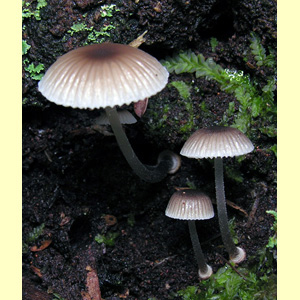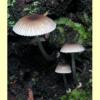
images/Mycena/Mycena_carmeliana_PG_GDSCN1455.jpg

Identification units
Seven identification units in Mycena are keyed out separately.
- Mycena cystidiosa is a little tougher than other species of Mycena, and therefore in the field it could be confused with Marasmius. Other distinctive features are the presence of criniform stipes and the thick-walled cystidia.
- Mycena leaiana has orange lamellae and a viscid pileus and stipe.
- Mycena nargan has white scales on the pileus.
- Mycena section Adonideae has non-amyloid spores.
- Mycena section Calodontes has pinkish to purple fruit-bodies that are comparatively robust compared to other Mycena (the stipe is up to 5 mm diam.) and the pileipellis hyphae are almost always smooth (rather than nodulose).
- Mycena section Sacchariferae has a pileipellis that does not consist of long, cylindrical, nodulose hyphae (as in most other Mycena) but has acanthocysts.
- Mycena (other) covers the rest of the Australian species of this diverse genus.
Citation
Mycena (Pers.) Roussel, Fl. Calvados, 2nd edn, 64 (1806).
